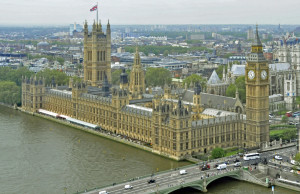The original Palace of Westminster, the London home of English kings before becoming the meeting place of Parliament, was almost completely destroyed by fire in 1834. Parliamentary committees rejected proposed classical designs they thought suggested the White House and U. S. Capitol, considered symbols of rebellion. They selected instead a style known as “perpendicular Gothic,” with three towers more than 300 feet tall. The building, completed in 1870, includes 1,100 rooms, 100 stairways, three miles of hallways and a shooting range. “Big Ben” is a bell, housed in the Elizabeth Clock Tower. The Chamber for the House of Commons was rebuilt after being bombed in World War II and intentionally has fewer seats than members.
The building incorporates traditions from earlier eras. The Lord Speaker of the House of Lords sits on a red sack of wool reflecting the central importance of wool to England’s medieval economy, a custom dating from the 14th century. A box of snuff near the entrance to the Commons Chamber has been kept full since at least the 17th century, when smoking was banned. Members of Parliament from opposing parties face each other on historic green-covered benches, with two red lines on the floor between them demarking an area where no one may stand. The lines are said to be two sword lengths apart to prevent dueling. MPs are expected to hang their swords on pink ribbons in the cloak room.
The best time to visit the Palace of Westminster is on Wednesdays, when the Prime Minister fields questions from the Leader of the Opposition, accompanied by heckling and cat calls. The session has gotten less raucous since the questioning time was moved to before lunch, when MPs used to down a pint or two to get ready, but it is still entertaining. Seats in the now shielded Strangers’ Gallery are limited, so plan ahead.

Comments are closed.